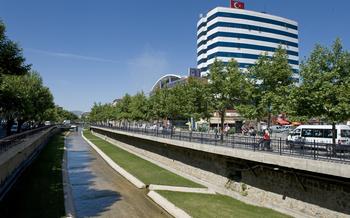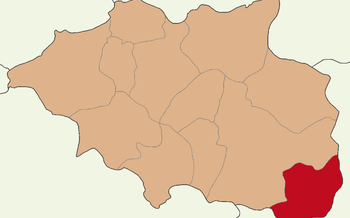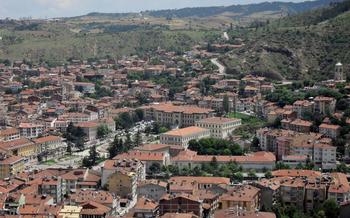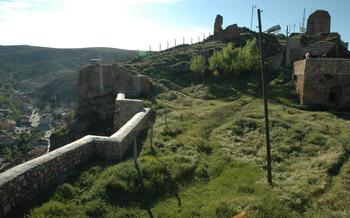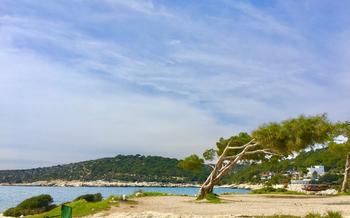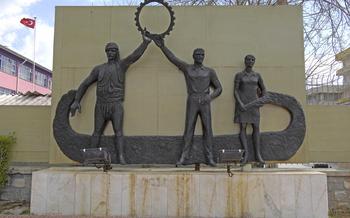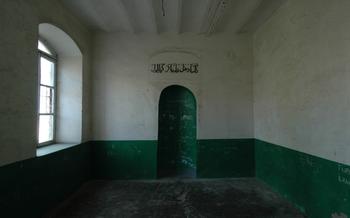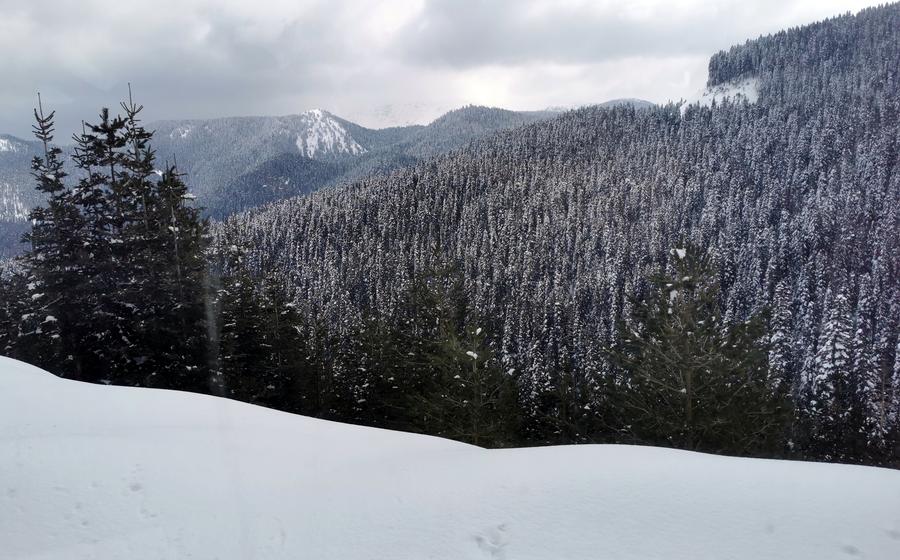
Pompeipolis Ancient City
- The Antiquity of Pompeipolis
- Exploring the Ruins
- The Amphitheater's Grandeur
- The Agora: Center of Commerce
- Temples and Religious Sites
- The Necropolis: City of the Dead
- The Museum of Pompeipolis: Preserving the Past
- Local Cuisine and Flavors
- Cultural Heritage and Traditions
- Accommodation Options
- Transportation and Accessibility
- Safety and Security
- Responsible Tourism
- Insider Tip: Unveiling the Hidden Treasures of Pompeipolis
- Unveiling the Village's Enchanting Charms
- Culinary Delights and Local Flavors
- A Journey into History and Culture
- Practical Tips for an Enriching Experience
- A Personal Anecdote: Discovering Küre's Hidden Charms
The Antiquity of Pompeipolis
Pompeipolis, an ancient city located in the Kastamonu province of Turkey, holds significant historical value. Founded in the 3rd century BC by Mithridates VI Eupator, king of Pontus, it flourished as a major port city and trading hub within the Roman Empire. Its strategic location along the Black Sea coast allowed for extensive trade connections, contributing to its wealth and prosperity.
The city's ruins, which have been extensively excavated and restored, offer a glimpse into the grandeur of ancient urban planning. The well-preserved remains of its amphitheater, agora, temples, and necropolis provide insights into the daily lives and cultural practices of its inhabitants.
One intriguing anecdote relates to a local farmer who discovered an ancient artifact while plowing his field near Pompeipolis. Upon closer examination, it turned out to be a beautifully crafted gold coin depicting the likeness of Mithridates VI himself. This serendipitous discovery highlights the rich history that lies beneath the surface of this ancient city, waiting to be uncovered.
Exploring the Ruins
Pompeipolis offers a fascinating journey through the remnants of its glorious past. The ruins are spread across a vast area, inviting visitors to discover the architectural marvels that once defined this ancient city. Must-see landmarks include the impressive amphitheater, the bustling agora, and the sacred temples.
Begin your exploration at the amphitheater, a colossal structure that once hosted gladiatorial contests and public performances. Marvel at its well-preserved seating tiers and imagine the roar of the crowd as they witnessed thrilling spectacles. Continue your journey to the agora, the heart of ancient Pompeipolis. Picture merchants displaying their wares, citizens engaging in lively debates, and the exchange of goods and ideas that shaped the city's economy.
Don't miss the temples dedicated to various deities, each showcasing unique architectural styles and intricate carvings. These sacred spaces provide a glimpse into the religious beliefs and practices of Pompeipolis's inhabitants.
To fully appreciate the site's grandeur, consider hiring a local guide who can share captivating stories and historical insights. Allow ample time for your visit, as the ruins are extensive and merit thorough exploration. Plan your trip during the shoulder seasons (spring or fall) to avoid the summer crowds and enjoy a more intimate experience.
The Amphitheater's Grandeur
The amphitheater of Pompeipolis stands as a testament to the city's grandeur and its importance as a center of entertainment. Built in the 2nd century AD, this impressive structure could accommodate up to 15,000 spectators, making it one of the largest amphitheaters in the Roman Empire. Its architectural features are a marvel of engineering, with a stage, seating tiers, and a sophisticated drainage system.
The amphitheater was the venue for various events, including gladiatorial contests and public performances. Gladiators, armed with swords and shields, engaged in fierce battles, thrilling the audience with their courage and skill. Actors and musicians also graced the stage, captivating spectators with their performances.
Today, the amphitheater stands in a remarkably preserved state, thanks to ongoing conservation efforts. Visitors can explore the seating tiers, imagine the roar of the crowd, and appreciate the acoustics that allowed performers to be heard clearly throughout the venue.
Anecdote:
During a visit to the amphitheater, I stumbled upon a reenactment of a gladiatorial fight. Actors dressed in authentic costumes engaged in a staged battle, complete with clashing swords and dramatic gestures. The performance transported me back in time, giving me a glimpse into the thrilling spectacles that once took place in this ancient arena.
The Agora: Center of Commerce
The agora, or marketplace, was the bustling heart of ancient Pompeipolis. Here, locals and visitors from neighboring towns gathered to buy and sell goods, exchange news, and socialize. The agora was a vibrant hub of activity, filled with the sounds of haggling merchants, the laughter of children, and the clinking of coins.
Architecturally, the agora was a marvel to behold. Colonnades lined the perimeter, providing shade from the scorching sun and supporting the weight of the upper floors. Within the colonnades, shops and stalls displayed a wide variety of goods, from exotic spices and fine fabrics to locally produced pottery and tools.
In addition to its commercial function, the agora served as a social and civic center. Public buildings, such as the town hall and the courthouse, were often located within or near the agora. Here, citizens could conduct official business, attend meetings, or simply catch up on the latest gossip.
During excavations of the agora, archaeologists discovered a wealth of artifacts that shed light on daily life in ancient Pompeipolis. These artifacts included coins, pottery fragments, and even a few well-preserved inscriptions. Together, these findings provide a glimpse into the economic, social, and cultural life of this ancient city.
Insider tip: For a truly authentic experience, visit the local shops near the agora. These shops sell traditional handicrafts, such as hand-woven rugs, copperware, and pottery. You can also find delicious local specialties like honey, cheese, and dried fruits.
Temples and Religious Sites
Pompeipolis harbored a diverse array of temples, each dedicated to a specific deity. These edifices showcased a myriad of architectural styles, reflecting the city's cosmopolitan character. The Temple of Zeus, with its imposing columns and intricate friezes, stood as a testament to the grandeur of the Olympian king. The Temple of Apollo, adorned with delicate carvings and graceful lines, exuded an air of harmony and elegance befitting the god of music and prophecy.
Archaeological excavations have unearthed a treasure trove of artifacts within these sacred spaces, shedding light on the religious practices and rituals of ancient Pompeipolis. Statues of deities, votive offerings, and inscriptions provide invaluable insights into the spiritual beliefs and customs of the city's inhabitants.
A compelling legend recounts a miraculous event that occurred at one of the temples. It is said that during a particularly harsh winter, the city was struck by a devastating famine. The desperate citizens turned to the gods for help, and their prayers were answered. From within the temple, a divine light emanated, and a miraculous spring erupted, providing sustenance and hope to the starving population.
Whether myth or reality, this legend underscores the profound significance of these temples in the lives of the ancient Pompeipolis people. They were not merely structures of stone and mortar but sacred spaces where the divine and the mortal intertwined, shaping the spiritual and cultural fabric of this ancient city.
The Necropolis: City of the Dead
The necropolis of Pompeipolis, also known as the City of the Dead, is a fascinating testament to the funerary practices and beliefs of the ancient Pompeipolis people. Situated outside the city walls, the necropolis served as the final resting place for Pompeipolis's inhabitants.
The necropolis is a vast area, with different types of tombs and burial practices reflecting the social status and beliefs of the deceased. From simple rock-cut tombs to elaborate chamber tombs, each burial site offers a glimpse into the lives and customs of ancient Pompeipolis.
Notable tombs within the necropolis include the Tomb of the Gladiator, featuring intricate reliefs depicting gladiatorial combat, and the Tomb of the Priestess, adorned with beautiful frescoes and inscriptions. These tombs provide valuable insights into the lives and achievements of influential individuals in ancient Pompeipolis.
Visiting the necropolis is a unique and poignant experience, allowing visitors to connect with the past and learn about the funerary customs of an ancient civilization. Its location, just a short distance from the main ruins of Pompeipolis, makes it a convenient addition to any visit to this ancient city.
The Museum of Pompeipolis: Preserving the Past
The Pompeipolis Museum, a testament to the city's rich history, proudly displays a diverse collection of artifacts that bring ancient Pompeipolis to life. Established in the heart of the city, the museum houses a treasure trove of sculptures, pottery, coins, and other relics that provide a glimpse into the daily lives, customs, and art of the Pompeipolis people.
Artifacts such as intricately carved statues, delicate pottery with colorful designs, and a wide array of coins narrate the story of Pompeipolis's cultural heritage and its connections with the wider Roman Empire. Visitors can marvel at the craftsmanship and artistry of these objects, which offer a tangible link to the past.
The museum also features informative exhibits and displays that provide context and historical background to the artifacts. These exhibits shed light on the city's founding, its role in the Roman Empire, and the daily lives of its inhabitants. Visitors can gain a deeper understanding of Pompeipolis's social structure, religious practices, and economic activities through these engaging displays.
For a truly immersive experience, guided tours led by knowledgeable museum staff are available. These tours offer visitors an in-depth exploration of the collection, providing insights into the significance of each artifact and its contribution to our understanding of Pompeipolis's rich history and legacy.
Local Cuisine and Flavors
The Kastamonu region boasts a rich and diverse culinary heritage, deeply influenced by Pompeipolis's historical significance. Traditional dishes have been passed down through generations, showcasing the region's unique blend of flavors and ingredients.
One must-try local specialty is keşkek, a hearty dish made from wheat, meat, and spices, slow-cooked to perfection. Another delicacy is mantı, small dumplings filled with minced meat and served with a yogurt-based sauce. For a taste of local pasta, try erişte, thin noodles often paired with meat or vegetables.
The culinary legacy of Pompeipolis is evident in the region's use of fresh, seasonal ingredients, reflecting the abundance of the surrounding land. Local markets offer a vibrant display of colorful fruits, vegetables, and spices, allowing visitors to immerse themselves in the local culinary culture.
To truly savor the authentic flavors of Kastamonu, venture into the local restaurants and cafes. Look for family-run establishments that have been serving traditional dishes for generations. These hidden gems often provide a glimpse into the region's culinary history and offer a warm and welcoming atmosphere.
When in Pompeipolis, be sure to indulge in the local cuisine and embark on a culinary journey that will leave your taste buds tantalized and your memories enriched.
Cultural Heritage and Traditions
The Kastamonu region is renowned for its rich cultural heritage and vibrant traditions that have been passed down through generations. The local handicrafts, folk dances, and music are a testament to the region's unique identity.
Handicrafts:
The Kastamonu region is home to skilled artisans who create exquisite handicrafts using traditional techniques. Visitors can find a wide variety of handmade items, including intricate carpets, colorful pottery, and finely woven textiles. These handicrafts not only showcase the region's artistic heritage but also provide a glimpse into the daily lives of the local people.
Folk Dances and Music:
The Kastamonu region is known for its lively folk dances and music that reflect the region's rich cultural heritage. The dances are often performed at festivals and celebrations and are characterized by their energetic movements and colorful costumes. The music is typically played on traditional instruments, such as the bağlama, and features intricate rhythms and melodies.
Festivals and Events:
Throughout the year, the Kastamonu region hosts a variety of festivals and events that celebrate local culture and traditions. These events provide an excellent opportunity for visitors to experience the region's vibrant atmosphere and engage with the local community. Some of the most popular festivals include the Kastamonu Cherry Festival, the Azdavay Bean Festival, and the Tosya Pumpkin Festival.
Accommodation Options
Pompeipolis offers a range of accommodation options to suit every budget and preference. Whether you seek budget-friendly guesthouses, comfortable hotels, or luxurious resorts, you'll find something to your liking in the area.
For a truly immersive experience, consider staying in a local guesthouse. These guesthouses, often family-run, offer a warm and welcoming atmosphere, allowing you to connect with the local culture and traditions. Many guesthouses also provide traditional Turkish breakfasts, a fantastic way to start your day of exploration.
If you prefer the comforts of a modern hotel, several options are available within easy reach of Pompeipolis. These hotels offer a range of amenities, including comfortable rooms, on-site restaurants, and swimming pools.
For those looking for a touch of luxury, several resorts in the region offer stunning views of the surrounding landscapes, private beaches, and world-class amenities. These resorts are perfect for those seeking a relaxing and rejuvenating getaway.
Insider Tip: For a truly unique experience, consider staying in a restored Ottoman mansion in the nearby village of Safranbolu. These beautifully preserved mansions offer a glimpse into the region's rich history and culture.
Transportation and Accessibility
Reaching Pompeipolis and the Kastamonu Region
Pompeipolis is easily accessible by various means of transportation, making it a convenient destination for travelers. The Kastamonu Airport (KST) is the closest airport, located approximately 40 kilometers from the ancient city. Direct flights from major cities in Turkey, such as Istanbul and Ankara, are available, providing a quick and comfortable journey.
For those arriving by road, the D-100 highway offers a scenic route to Pompeipolis. Well-maintained roads ensure a smooth and safe drive, passing through picturesque landscapes and charming villages along the way. Regular bus services are also available from major cities, providing an affordable and convenient option for budget-conscious travelers.
Once in the region, local transportation options are readily available. Rental cars are a popular choice for those who prefer the flexibility of exploring the area at their own pace. Taxis and minibuses are also widely accessible, offering convenient transportation to and from Pompeipolis and other nearby attractions.
For a more immersive and hassle-free experience, guided tours are highly recommended. Local tour operators offer a variety of packages, ranging from day trips to multi-day itineraries, ensuring a comprehensive exploration of Pompeipolis and its surroundings. These tours often include transportation, knowledgeable guides, and additional activities such as trekking, birdwatching, and cultural experiences.
Travel Times and Costs
The travel time to Pompeipolis varies depending on the chosen mode of transportation. By air, direct flights from Istanbul or Ankara take approximately 1 hour. By road, the journey from Kastamonu city takes around 45 minutes, while from larger cities like Istanbul or Ankara, it can take up to 6 hours.
Transportation costs are generally affordable. Flight tickets from major cities to Kastamonu Airport range from 50 to 100 euros. Bus fares are even more economical, starting from 10 euros for a one-way trip. Car rental prices vary depending on the type of vehicle and rental duration, typically starting at 20 euros per day.
To ensure a smooth and enjoyable journey, it's advisable to plan your transportation in advance. Check flight schedules, book tickets, and arrange car rentals well ahead of time, especially during peak tourist seasons.
Safety and Security
Traveling to Pompeipolis and the Kastamonu region is generally considered safe for tourists. The local community is known for its hospitality and welcoming nature. However, as with any travel destination, it's essential to take precautions to ensure a safe and enjoyable trip. Respecting local customs and traditions is crucial to avoid any misunderstandings or offense. It's advisable to dress modestly, especially when visiting religious sites or conservative areas.
Staying vigilant and aware of your surroundings is always recommended, particularly in crowded places. Avoid carrying large amounts of cash or valuables, and keep your belongings close at hand. If you're exploring remote areas or hiking in the surrounding mountains, it's wise to inform someone about your plans and carry a map or GPS device.
In case of an emergency, there are several resources available to travelers. The local police and gendarmerie are generally reliable and can be contacted in case of any issues. Emergency contact information, including phone numbers and addresses of hospitals and medical facilities, is readily available online or at your hotel's reception.
By following these safety tips and exercising common sense, you can ensure a safe and enjoyable travel experience in Pompeipolis and the Kastamonu region.
Responsible Tourism
Preserving Pompeipolis's Legacy: As you explore the ancient city of Pompeipolis, remember the importance of practicing responsible tourism. Respect the historical significance of the site by refraining from touching or damaging any artifacts or structures. Opt for guided tours that prioritize the preservation of the ruins and support local businesses that promote sustainable practices. By minimizing your environmental impact and respecting the local community, you can help ensure that future generations can also appreciate the wonders of Pompeipolis.
Local Initiatives: Several organizations are working to promote responsible tourism in the Kastamonu region. The Pompeipolis Preservation Society, for instance, focuses on protecting the ancient city and promoting sustainable practices. The Kastamonu Tourism Board also plays a crucial role in supporting local businesses and developing responsible tourism initiatives. By supporting these organizations, you can contribute to the long-term sustainability of Pompeipolis and the surrounding region.
Your Role as a Visitor: As a visitor, you have a responsibility to tread lightly and respect the local customs and traditions. Engage with the local community, support local businesses, and learn about the region's rich cultural heritage. By embracing responsible tourism, you can help preserve the unique charm and authenticity of Pompeipolis for years to come.
Insider Tip: Unveiling the Hidden Treasures of Pompeipolis
Beyond the well-trodden paths of Pompeipolis, a hidden gem awaits discovery – the charming village of Küre. Nestled amidst picturesque landscapes, Küre offers a glimpse into the region's authentic traditions and warm hospitality.
Unveiling the Village's Enchanting Charms
Küre is a treasure trove of cultural heritage, renowned for its traditional handicrafts, vibrant folklore, and delectable cuisine. Stroll through the village's narrow cobblestone streets, lined with quaint shops showcasing exquisite handwoven carpets, intricate pottery, and shimmering jewelry. Immerse yourself in the rhythmic beats of traditional music and witness the graceful movements of folk dancers, their colorful costumes adding a splash of vibrancy to the village square.
Culinary Delights and Local Flavors
Indulge in a culinary adventure at Küre's local restaurants, where the air is filled with the enticing aromas of freshly baked bread, sizzling kebabs, and aromatic stews. Savor the flavors of keşkek, a hearty dish made from wheat, meat, and chickpeas, or sample the delectable mantı, delicate dumplings filled with minced meat and yogurt sauce. Don't miss the chance to taste erişte, a traditional noodle dish that is a local specialty.
A Journey into History and Culture
Küre is steeped in history, with ancient ruins and historical landmarks scattered throughout the village. Visit the Küre Museum to learn about the region's rich past and admire artifacts that tell the story of its inhabitants. Explore the village's mosques and churches, each with its unique architectural style and religious significance.
Practical Tips for an Enriching Experience
To fully embrace the essence of Küre, engage with the friendly locals who are eager to share their stories and traditions. Respect local customs and dress modestly to show your appreciation for the village's culture. For an immersive experience, consider staying at a local guesthouse, where you'll be welcomed with warm hospitality and treated to authentic Turkish cuisine.
A Personal Anecdote: Discovering Küre's Hidden Charms
During my travels, I stumbled upon Küre quite by accident. Intrigued by its unassuming appearance, I decided to venture into the village. As I explored its winding streets, I was captivated by the vibrant energy, the friendly smiles, and the sense of community that permeated the air.
In a small café, I struck up a conversation with a local artisan who shared stories of his craft and the village's rich history. Over cups of freshly brewed tea, I learned about the significance of Küre's traditional handicrafts and the artisans who dedicated their lives to preserving these ancient techniques.
My visit to Küre was a serendipitous discovery that left an indelible mark on my heart. It reminded me of the importance of embracing the unknown and seeking out the hidden gems that often lie just off the beaten path.
